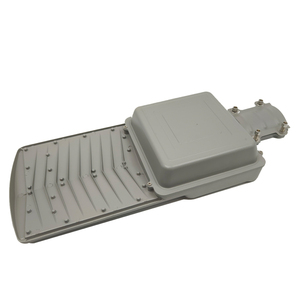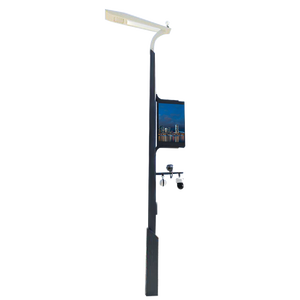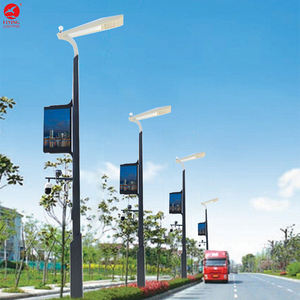
All categories
Featured selections
Trade Assurance
Buyer Central
Help Center
Get the app
Become a supplier

(4345 products available)





















































street light function are a modern solution for illuminating streets, pathways, and public spaces using solar energy. These innovative lighting systems harness sunlight through photovoltaic panels during the day and store it in batteries for night-time use. By converting solar power into electricity, street light function offer an eco-friendly, cost-effective alternative to traditional street lighting methods. With advancements in technology, these lights are becoming increasingly efficient, providing bright and reliable illumination while reducing reliance on conventional energy sources.
There are several types of street light function available, each designed to meet specific needs and conditions. Integrated solar street lights combine all components, such as solar panels, LED lights, and batteries, into a single unit, offering ease of installation and maintenance. Split solar street lights feature separate solar panels and lighting units, providing flexibility in positioning and optimizing sunlight exposure. All-in-one solar street lights are similar to integrated versions but often include advanced sensors and smart controls. Hybrid solar street lights utilize both solar and grid power, ensuring uninterrupted lighting even during cloudy days or extended periods of low sunlight. Each type of street light function is engineered to provide efficient lighting solutions tailored to diverse environments.
street light function are equipped with numerous functionalities that enhance their performance and usability. One of the primary features is the automatic dusk-to-dawn operation, where the lights switch on at sunset and off at sunrise without manual intervention. Advanced models may include motion sensors that increase brightness when movement is detected, conserving energy when the area is unoccupied. Weather-resistant designs ensure durability in harsh climates, while high-efficiency LEDs provide bright illumination with minimal energy consumption. Additionally, some street light function offer adjustable settings for brightness and timing, allowing customization based on specific requirements or preferences.
The construction of street light function involves various components and materials to ensure optimal functionality and longevity. Photovoltaic panels, made from monocrystalline or polycrystalline silicon, are crucial for capturing solar energy. Energy storage is facilitated by lithium-ion or lead-acid batteries, depending on the design and capacity needs. LED bulbs are preferred for their energy efficiency and long lifespan, delivering consistent lighting while minimizing maintenance. The housing of street light function is typically crafted from durable materials such as aluminum or stainless steel, offering corrosion resistance and protection against the elements. Each component is meticulously selected to maximize efficiency and provide reliable, long-term lighting solutions.
Proper installation and usage are vital for maximizing the benefits of street light function. Before installation, assess the location to ensure adequate sunlight exposure and avoid obstructions like trees or buildings. Position the solar panel at an angle that optimizes sun capture throughout the day. Regular maintenance, such as cleaning the panels and checking battery health, is essential for efficient operation. When using street light function, adjust settings to suit the environment or specific lighting needs, ensuring energy is conserved while maintaining adequate illumination. By following these guidelines, users can enjoy sustainable and effective lighting solutions that contribute to energy savings and environmental conservation.
When selecting street light function, it's essential to consider several factors to ensure they meet the specific needs of the area they will illuminate. First, evaluate the location's sun exposure. Areas with abundant sunlight are ideal for solar lighting, as they allow the solar panels to charge effectively during the day. Additionally, consider the light's capacity and brightness. Higher lumen output means more powerful illumination, which is crucial for larger spaces or areas requiring enhanced security. The battery type and capacity are also important, as they determine how long the lights can function during cloudy days or extended nights. By matching these factors with the intended use, you can choose street light function that provide optimal performance.
Another consideration is the design and aesthetic of street light function. While functionality is paramount, the visual appeal can enhance the overall look and feel of the environment. Some models offer sleek, modern designs that complement urban settings, while others may be more traditional to suit rural or residential areas. Additionally, the durability and material composition should be assessed. Weather-resistant materials such as aluminum or stainless steel provide longevity and withstand harsh conditions, ensuring the lights maintain their efficiency over time. The choice of design and materials should align with both practical and aesthetic requirements.
The lifespan of street light function varies based on the quality of components used, such as solar panels, batteries, and LEDs. Generally, high-quality solar street lights can last anywhere from 5 to 10 years. Regular maintenance and timely replacement of batteries can extend their operational life. It's crucial to choose models with reputable components to ensure durability and reliability.
While street light function rely on sunlight to charge, they can still be effective in areas with limited sun exposure. Hybrid models, which utilize both solar and grid power, are particularly useful in such conditions. Additionally, lights equipped with efficient batteries can store energy for use during cloudy days or extended periods without sunlight, maintaining consistent illumination.
Yes, street light function can be used in cold climates, provided they are designed with weather-resistant materials and components that withstand low temperatures. It's important to ensure the battery and solar panel are capable of functioning effectively in cold weather. Some models are specially designed for such environments, offering robust performance despite the challenging conditions.
Motion sensors in street light function enhance efficiency by adjusting the brightness based on movement detection. When no movement is detected, the lights operate at a lower brightness, conserving energy. Upon detecting motion, the brightness increases, providing sufficient illumination only when needed. This feature not only saves energy but also extends battery life, ensuring reliable operation.
Maintenance of street light function includes regular cleaning of solar panels to ensure maximum sun exposure and checking the battery health periodically. Inspecting the lights for any physical damage and ensuring all components are functioning properly is also crucial. Depending on the environment, replacing the battery after a few years may be necessary to maintain optimal performance. Routine maintenance helps prolong the lifespan and efficiency of solar street lighting systems.